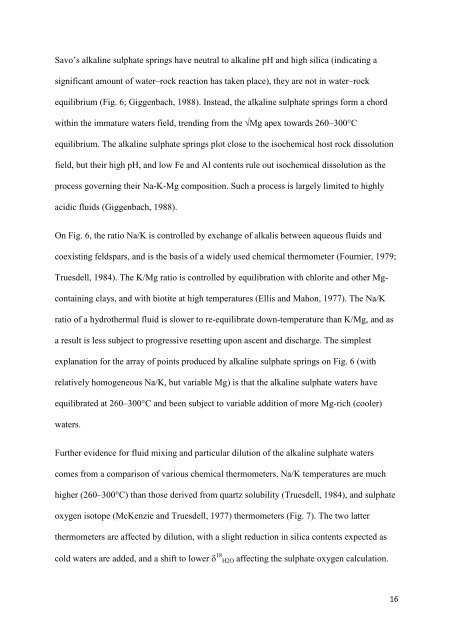Alkaline sulphate fluids produced in a magmatic hydrothermal system
Alkaline sulphate fluids produced in a magmatic hydrothermal system
Alkaline sulphate fluids produced in a magmatic hydrothermal system
You also want an ePaper? Increase the reach of your titles
YUMPU automatically turns print PDFs into web optimized ePapers that Google loves.
Savo’s alkal<strong>in</strong>e <strong>sulphate</strong> spr<strong>in</strong>gs have neutral to alkal<strong>in</strong>e pH and high silica (<strong>in</strong>dicat<strong>in</strong>g a<br />
significant amount of water–rock reaction has taken place), they are not <strong>in</strong> water–rock<br />
equilibrium (Fig. 6; Giggenbach, 1988). Instead, the alkal<strong>in</strong>e <strong>sulphate</strong> spr<strong>in</strong>gs form a chord<br />
with<strong>in</strong> the immature waters field, trend<strong>in</strong>g from the √Mg apex towards 260–300°C<br />
equilibrium. The alkal<strong>in</strong>e <strong>sulphate</strong> spr<strong>in</strong>gs plot close to the isochemical host rock dissolution<br />
field, but their high pH, and low Fe and Al contents rule out isochemical dissolution as the<br />
process govern<strong>in</strong>g their Na-K-Mg composition. Such a process is largely limited to highly<br />
acidic <strong>fluids</strong> (Giggenbach, 1988).<br />
On Fig. 6, the ratio Na/K is controlled by exchange of alkalis between aqueous <strong>fluids</strong> and<br />
coexist<strong>in</strong>g feldspars, and is the basis of a widely used chemical thermometer (Fournier, 1979;<br />
Truesdell, 1984). The K/Mg ratio is controlled by equilibration with chlorite and other Mgconta<strong>in</strong><strong>in</strong>g<br />
clays, and with biotite at high temperatures (Ellis and Mahon, 1977). The Na/K<br />
ratio of a <strong>hydrothermal</strong> fluid is slower to re-equilibrate down-temperature than K/Mg, and as<br />
a result is less subject to progressive resett<strong>in</strong>g upon ascent and discharge. The simplest<br />
explanation for the array of po<strong>in</strong>ts <strong>produced</strong> by alkal<strong>in</strong>e <strong>sulphate</strong> spr<strong>in</strong>gs on Fig. 6 (with<br />
relatively homogeneous Na/K, but variable Mg) is that the alkal<strong>in</strong>e <strong>sulphate</strong> waters have<br />
equilibrated at 260–300°C and been subject to variable addition of more Mg-rich (cooler)<br />
waters.<br />
Further evidence for fluid mix<strong>in</strong>g and particular dilution of the alkal<strong>in</strong>e <strong>sulphate</strong> waters<br />
comes from a comparison of various chemical thermometers. Na/K temperatures are much<br />
higher (260–300°C) than those derived from quartz solubility (Truesdell, 1984), and <strong>sulphate</strong><br />
oxygen isotope (McKenzie and Truesdell, 1977) thermometers (Fig. 7). The two latter<br />
thermometers are affected by dilution, with a slight reduction <strong>in</strong> silica contents expected as<br />
cold waters are added, and a shift to lower δ 18 H2O affect<strong>in</strong>g the <strong>sulphate</strong> oxygen calculation.<br />
16
















